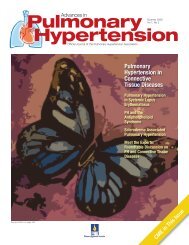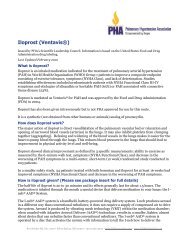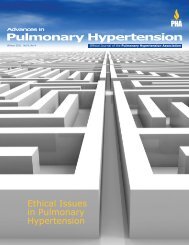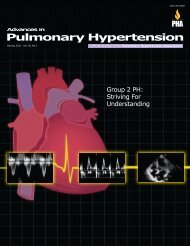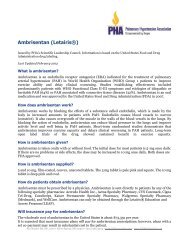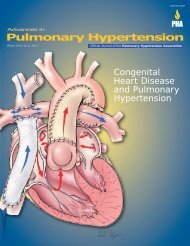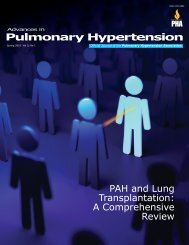Advances in Pulmonary Hypertension - PHA Online University
Advances in Pulmonary Hypertension - PHA Online University
Advances in Pulmonary Hypertension - PHA Online University
You also want an ePaper? Increase the reach of your titles
YUMPU automatically turns print PDFs into web optimized ePapers that Google loves.
Precautions<br />
When plann<strong>in</strong>g cardiac catheterization for a patient with suspected<br />
PAH, it is important to understand the risks associated<br />
with the procedure, and to have an emergency treatment plan<br />
<strong>in</strong> place should these risks occur. In addition, the desired<br />
measurements should be planned <strong>in</strong> advance, with careful<br />
consideration of the specific operational procedures that are<br />
to be done dur<strong>in</strong>g the procedure.<br />
Cl<strong>in</strong>icians should be very familiar with how to <strong>in</strong>terpret the<br />
measurements obta<strong>in</strong>ed at cardiac catheterization, and be<br />
able to troubleshoot suspected <strong>in</strong>accuracies. Anticipation of<br />
complications and unexpected f<strong>in</strong>d<strong>in</strong>gs is essential, so that<br />
immediate action can be taken. F<strong>in</strong>ally, the cl<strong>in</strong>ician must<br />
cont<strong>in</strong>uously scrut<strong>in</strong>ize the f<strong>in</strong>d<strong>in</strong>gs and question the measurements<br />
for both accuracy and cl<strong>in</strong>ical relevance.<br />
Patients with PAH may present with relatively few physical<br />
signs of PAH, yet have significant cardiovascular abnormalities.<br />
These patients, with “compensated right-heart failure,”<br />
can easily decompensate when subjected to the stressors of<br />
cardiac catheterization. Despite these risks, however, cardiac<br />
catheterization is safe if appropriate precautions are carried<br />
out.<br />
• Staff experience – The physician and nurs<strong>in</strong>g and technical<br />
staff must all be familiar with the diagnosis and management<br />
of PAH and with the catheterization laboratory equipment.<br />
The staff must be meticulous about flush<strong>in</strong>g and level<strong>in</strong>g<br />
the pressure transducers and flush<strong>in</strong>g the catheter to<br />
ensure that accurate measurements are recorded.<br />
• Patient sedation – It is generally recommended that<br />
adult patients be kept awake dur<strong>in</strong>g catheterization. However,<br />
it is important that anxiety, which may <strong>in</strong>duce tachycardia and<br />
hemodynamic embarrassment, be controlled. Small doses of<br />
benzodiazep<strong>in</strong>es are useful for controll<strong>in</strong>g anxiety. Close attention<br />
to cont<strong>in</strong>uous pulse oximetry is required, however, as<br />
hypoxemia dur<strong>in</strong>g catheterization is not uncommon.<br />
• Atrial and ventricular ectopy – As the catheter is manipulated<br />
<strong>in</strong>to positions <strong>in</strong> the right atrium and ventricle, ectopic<br />
electrical activity is common. Usually, atrial premature beats<br />
and ventricular ectopic beats are brief and self-limited.<br />
Susta<strong>in</strong>ed activity <strong>in</strong>clud<strong>in</strong>g atrial and ventricular tachycardia<br />
may occur, however. Immediate reposition<strong>in</strong>g or removal of<br />
the catheter is required <strong>in</strong> these <strong>in</strong>stances, and antiarrhythmic<br />
therapy should always be available should the arrhythmia persist.<br />
• Bradyarrhythmias – One of the most troublesome complications<br />
of cardiac catheterization <strong>in</strong> patients with PAH is the<br />
development of vagally mediated bradycardia and hypotension.<br />
Often, an anxious or sensitive patient may develop<br />
<strong>in</strong>creased vagal tone 1) on view<strong>in</strong>g the catheterization <strong>in</strong>struments<br />
or dur<strong>in</strong>g local anesthetic <strong>in</strong>fusion; 2) on <strong>in</strong>sertion of<br />
the catheter; or 3) on removal of the catheter. When these<br />
“vagal episodes” occur, profound bradycardia and hypotension<br />
often ensue with<strong>in</strong> 30 to 60 seconds. It can be extremely difficult<br />
to resuscitate such a patient. Therefore, it is imperative<br />
that a vagal episode is anticipated <strong>in</strong> all patients, and that it<br />
is recognized and treated with atrop<strong>in</strong>e early <strong>in</strong> its course.<br />
This author always keeps an open vial of atrop<strong>in</strong>e at the bedside<br />
before, dur<strong>in</strong>g, and after cardiac catheterization of a<br />
patient with pulmonary hypertension.<br />
16 <strong>Advances</strong> <strong>in</strong> <strong>Pulmonary</strong> <strong>Hypertension</strong><br />
<strong>Pulmonary</strong> Artery Pressure<br />
(mmHg)<br />
80<br />
70<br />
60<br />
50<br />
A B<br />
Patient #8 Patient #6<br />
• Reliability of measurements – Cardiac catheterization<br />
measurements should be made preferably when the patient<br />
is sup<strong>in</strong>e, with anxiety m<strong>in</strong>imized (see above), and at steady<br />
state. Spontaneous variation <strong>in</strong> hemodynamics over time is<br />
a known shortcom<strong>in</strong>g of cardiac catheterization (Figure 2), 5<br />
and thus great care should be taken to ensure that all measurements<br />
are taken <strong>in</strong> close proximity of each other. In general,<br />
wait<strong>in</strong>g at least 15 m<strong>in</strong>utes after catheter <strong>in</strong>sertion is<br />
advisable. Hemodynamic measurements should then be<br />
obta<strong>in</strong>ed as close together as possible.<br />
Choice of Venous Access Sites<br />
Commonly, the right <strong>in</strong>ternal jugular ve<strong>in</strong> is used for <strong>in</strong>sertion<br />
of a venous sheath through which the pulmonary artery<br />
catheter is passed. Other sites can be advantageous, depend<strong>in</strong>g<br />
on the situation (Table 1). For a patient’s <strong>in</strong>itial catheterization,<br />
use of the femoral ve<strong>in</strong>s for catheterization may be<br />
preferred, because it allows the greatest flexibility with which<br />
the cl<strong>in</strong>ician can perform the most thorough evaluation. This<br />
is especially important for exclud<strong>in</strong>g left heart pathology when<br />
direct measuremebnt of left ventricular end diastolic pressure<br />
is necessary.<br />
Measurements to Record<br />
Standard right-heart catheterization measurements (Figure 3)<br />
<strong>in</strong>clude:<br />
• right atrial • pulmonary arterial (PA)<br />
pressure (RAP) (“mixed venous”) saturation<br />
• right ventricular • superior vena cava<br />
pressure (RVP) (SVC) saturation*<br />
• pulmonary arterial • <strong>in</strong>ferior vena cava<br />
pressure (PAP) (IVC) saturation*<br />
• pulmonary capillary • right atrial (RA)<br />
wedge pressure (PCWP) saturation*<br />
• systemic arterial • right ventricular<br />
pressure (BP) and heart<br />
rate<br />
• cardiac output (CO)<br />
• pulmonary arterial<br />
vasoreactivity<br />
(RV) saturation*<br />
*When <strong>in</strong>dicated.<br />
1 2 3 4 5 6<br />
Hour<br />
19<br />
17<br />
15<br />
13<br />
Total <strong>Pulmonary</strong> Resisitance<br />
(units)<br />
<strong>Pulmonary</strong> Artery Pressure<br />
(mmHg)<br />
70<br />
60<br />
50<br />
40<br />
1 2 3 4 5 6<br />
Hour<br />
Fig. 2—Spontaneous variation <strong>in</strong> pulmonary arterial hemodynamics<br />
over time.<br />
5.0<br />
4.0<br />
3.0<br />
Cardiac Output (L / m<strong>in</strong>)



